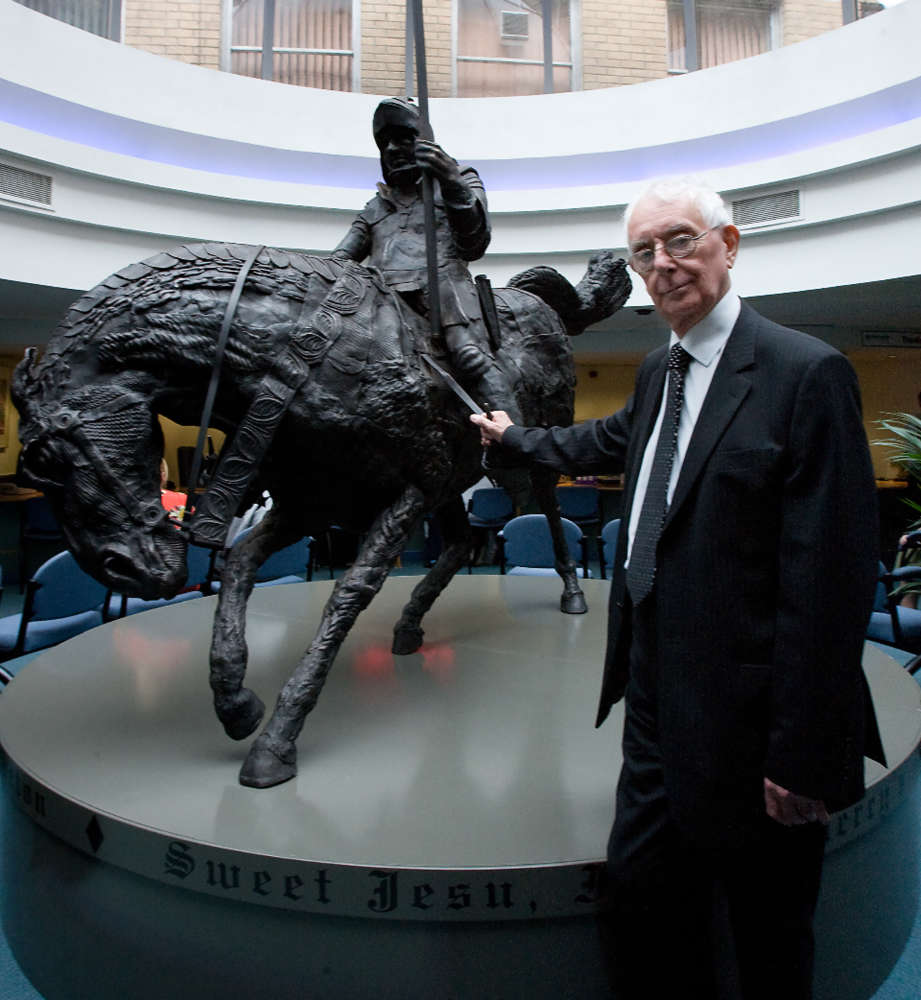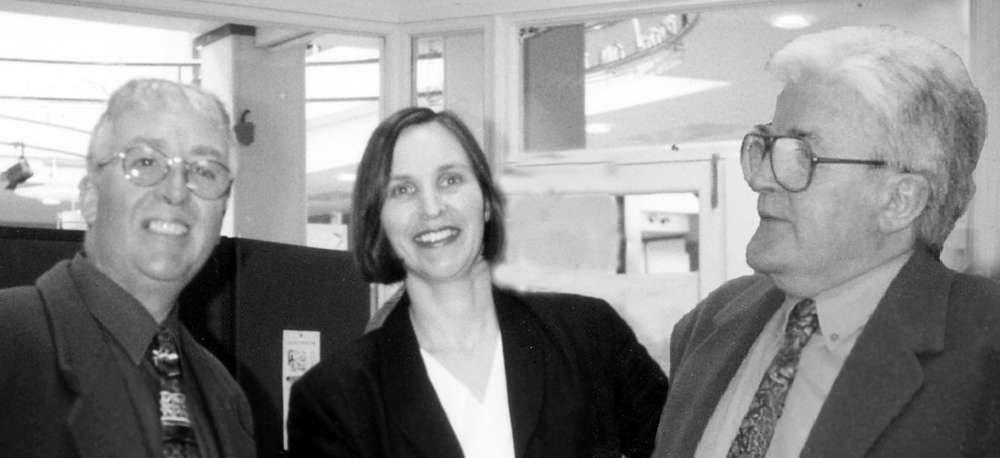
The Black Knight statue stood in the Ashton Arcades for years but at some point, it disappeared from view. Now, two local brothers have been finding out where it went and what the future is for the forgotten statue.
Philip and David Williams of Hoyd Publishing are well known in Tameside for their publications that have focused in on Ashton Under Lyne history and lore. And as of late, they have turned their attention to the Black Knight statue.
The statue the brothers were tracking down was commissioned for the Arcades Shopping Centre and was unveiled at the centre’s opening in October 1995. The artist responsible for its creation was Dutch-born Marjan Wouda, who spent a month delving into the history of the town and researching the local legend of the Black Knight.
It remained at the site until 2006, when it was removed due to the centre being renovated by new owners. At the time, there was no mention of this by the Arcade owners or the council.
Philip and David told us where the statue ended up after this, saying “the statue was brought back to its former glory in 2009 - it was also to undergo a new appearance, with the bronze sculpture being re-coloured black. On completion of the work, the sculpture was made a focal point within the customer service centre at the Council’s Ashton offices. It was unveiled by executive leader Cllr Roy Oldham on July 9th, 2009. At the end of his speech, Cllr. Oldham said, “The Black Knight is synonymous with Ashton, and I am delighted that we have been able to restore the statue and put it on display.”

There it remained until 2015 when work began on ‘Vision Tameside’ and the development of ‘Tameside One’, which necessitated the demolition of the old council offices and ancillary offices, including the customer service centre. This ultimately brought back the question again as to where the statue had gone.
To realise why the brothers Philip and David were invested in tracking the statue down, they gave us some background on the statue that they were trying to hunt down, saying “the legend has it that the Black Knight was an evil man named Sir Ralph de Assheton who lived in the ‘Old Hall’. Locals lived in fear of him as he would ride around the town tyrannising everyone mounted on his huge black horse, which was just as fearsome as its master. It is said that if anyone crossed Sir Ralph or caused him any displeasure at all, he would have them placed into a barrel spiked with nails and rolled down a hill. Such a fate was one that supposedly befell his wife, ‘Anne’. Indeed, it has also been said that a similar end was meted out to his other wives, of which he was supposed to have had 100 or more.”

Whilst still a legend, the story of Sir Ralph de Assheton created a legacy that is in many ways still seen in Ashton today – the black knight is still featured as the towns mascot and was present on the Arcades logo for a long time. However, in the past traditions also took place during easter – the time he was reportedly killed. The brothers gave us more information on how this tradition came to be -
“The reign of fear carried out by Sir Ralph, tagged the ‘Black Knight’ for all his cruel deeds, ended one Easter Monday. While out on the streets of Ashton enjoying yet another ride of terror, he was shot dead by a local inhabitant, or, as some people say, by a member of his wife’s family. In celebration of his death, the custom of ‘Riding the Black Lad’ was derived - every Easter, various effigies were paraded through the town, with many dressed as a knight. To bring some organisation to these unruly ridings, they were eventually transformed into the Black Knight pageants. At one time, these spectacular events with all their splendour rivalled London’s Lord Mayor’s Show, attracting more than 100,000 people to the town’s streets. Each year, the mayor, prior to the parade, would crown the pageant and cotton queens. The pageants are themselves now part of the past, although attempts to revive them have been made over the years. Even without the pageants, the legend of the Black Knight remains to this day.”
Knowing the history behind the statue and the story, the brothers started off contacting the council and submitting a FOI request. “We contacted Tameside MBC with our questions about the sculpture, and happily, we have recently received their response. The response from Tameside Council came from Lynsey Potter, the Information and Data Manager, who stated... When the decant from the previous Council building took place, the Council’s Estates ensured the sculpture was safely stored at a Council depot. It has since been relocated to another Council depot, but yes, we are aware of its storage location.

“The Council spokesperson went on to say that the sculpture has not been forgotten about, though no reference to it being raised at a Council meeting could be found.”
We also asked if anyone on the Council has ever thought of what is going to happen with it. We also stated that although we realise that the statue was never actually commissioned by Tameside Council, but having rescued it once and taken over its custodianship, is it not time to find it another suitable home? We know it was not conceived as an outdoor sculpture, but couldn’t architects have devised a covered home for it in the impending revamp of the town centre marketplace? Was this ever even thought of? Or is there still time for this to happen?
Lynsey Potter’s reply was... I can confirm that a formal discussion took place (not in a Council meeting) in respect of including the Black Knight within the Market Square redevelopment works; however, I have been informed that the statue was designed and constructed for indoor uses and so is not included as part of the design for the outdoor Market Square works. The Council will always be open to ideas for the sculpture’s future location, but as its current custodian, the Council must also consider the future of the sculpture in terms of Health & Safety and accessibility, for instance.”
So for now, the future of the black knight statue that once adorned the centre of the Ashton Arcades is very much uncertain, but one day the legend of Sir Ralph de Assheton may come back into the public view.


 Police Federation head dubious of PM's 'new bobbies' promise
Police Federation head dubious of PM's 'new bobbies' promise
 TransPennine Express steps in to keep passengers moving this Easter weekend
TransPennine Express steps in to keep passengers moving this Easter weekend
 New Timetables For Trains Across The North In May
New Timetables For Trains Across The North In May
 800 cannabis plants seized in Mossley
800 cannabis plants seized in Mossley


